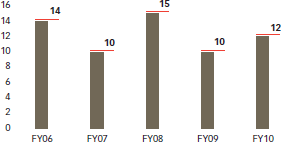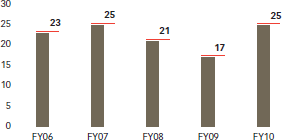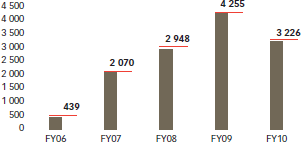![Harmony [logo]](i/logo.png)
![Harmony [logo]](i/print_logo.png)

- Home <
- Business review <
- Harmony and sustainability
Harmony and sustainability
Harmony’s approach to sustainability reporting
Harmony has adopted the principle of integrated reporting for its 2010 annual and sustainability reports. It recognises that integrated reporting combines reporting on its financial and non-financial performances, and provides a holistic view of the company by explaining and promoting understanding of the cause and effect of the various issues affecting the bottom-line.
The overall aim of Harmony’s reporting effort is improved communication with shareholders and the broader group of stakeholders, to build up a formal, approved record of the company’s financial and non-financial performance, and to comply with the listing requirements of the various stock exchanges on which Harmony is listed.
Social, environmental and economic considerations of the business, the opportunities and challenges they present, and the company’s performance in these respects are presented throughout the annual report. Because Harmony believes that it is important to report in greater detail than is feasible in the annual report, and in line with its commitment to report in line with the Global Reporting Initiative (GRI), the company has also produced a separate, more detailed Sustainable Development Report 2010 that is available online.
Certain key performance indicators have been assured by PriceWaterhouseCoopers in accordance with their brief to assure these performance indicators and Harmony’s reporting to a B+ level. This assurance statement my be found below.
Harmony identified what it considers to be the most material sustainability issues for inclusion in this year’s Sustainable Development Report. This identification process was undertaken, discipline by discipline, by means of workshops and the gathering of feedback by the individual discipline heads through continuous and regular interaction and discourse with stakeholders. The material issues identified, Harmony’s performance in FY2010 and targets for FY2011 are tabulated below.
For more detailed information, go to the Sustainable Development Report 2010.
Independent assurance report to the Directors of Harmony Gold Mining Company Limited
Introduction
We have been engaged by the Directors of Harmony Gold Mining Company Limited (Harmony) to perform an independent assurance engagement in respect of certain South African Identified Sustainability Information included in Harmony’s Annual Report 2010 for the year ended 30 June 2010. Additional indicators were also included and assured in the Harmony Sustainable Development Report 2010 and a separate assurance report is included therein.
Scope and subject matter
The following South African Identified Sustainability Information reported in the Annual Report was selected for an expression of limited assurance:
- BBBEE procurement expenditure in South African rands and this as a percentage of total expenditure
- Total number of significant environmental incidents
- Total energy consumption in MWh
- Total CO2; emissions in tonnes
- Total amount of water used for primary activities in m³
- Total cyanide usage in tonnes
- Total number of fatalities
- Lost-time injury frequency rate (LTIFR)
- Total number of shifts lost due to accidents and illnesses
- Total number of individuals on highly active anti-retroviral therapy (HAART)
- Total number of new tuberculosis (TB) cases identified
- Total number of new silicosis cases identified
- Total number of new noise-induced hearing loss (NIHL) cases reported
- Staff turnover levels
- Percentage of HDSAs in management
- Percentage of women in mining
- Total amount spent on corporate social responsibility (CSR) programme
- Total amount spent on local economic development (LED) projects
- Harmony’s assertion that it has achieved a B+ Global Reporting Initiative (GRI) application level
Our responsibilities do not extend to any other information.
Responsibilities of the Directors
Harmony’s Directors are responsible for the preparation and presentation of the Identified Sustainability Information, as incorporated in the 2010 Annual Report, in accordance with their internally defined procedures and for maintaining adequate records and internal controls that are designed to support the reporting process.
Responsibility of the independent assurance provider
Our responsibility is to conduct a limited assurance engagement and, based on our assurance procedures, report our conclusions to the directors.
We conducted our engagement in accordance with the International Standard on Assurance Engagements (ISAE) 3000, Assurance engagements other than audits or reviews of historical financial information issued by the International Auditing and Assurance Standards Board. This standard requires that we comply with ethical requirements and plan and perform the assurance engagement to obtain assurance on the Identified Sustainability Information as per the terms of our engagement.
Summary of work performed
Our procedures included examination, on a test basis, of evidence relevant to the Identified Sustainability Information. It also included an assessment of the significant estimates and judgements made by the Directors in the preparation of the Identified Sustainability Information.
Our work consisted of:
- reviewing processes that Harmony have in place for determining the Identified Sustainability Information included in the Annual Report;
- obtaining an understanding of the systems used to generate, aggregate and report the Identified Sustainability Information at the sampled operations;
- conducting interviews with management at the sampled operations and at corporate head office;
- evaluating the data generation and reporting processes against the reporting criteria;
- performing key controls testing and testing the accuracy of data reported on a sample basis; and
- reviewing the consistency between the Identified Sustainability Information and related statements in Harmony’s Annual Report.
We believe that the evidence we have obtained is sufficient and appropriate to provide a basis for our limited assurance conclusion. Harmony’s internal corporate reporting criteria and the Global Reporting Initiative’s (GRI) new generation (G3) guidelines were applied for evaluating the Identified Sustainability Information. The Glossary of terms and acronyms provides detail on the applied definitions of the Identified Sustainability Information.
Inherent limitations
Non-financial data is subject to more inherent limitations than financial data, given both the nature and the methods used for determining, calculating, sampling or estimating such data. Qualitative interpretations of relevance, materiality and the accuracy of data are subject to individual assumptions and judgements.
Conversion factors used to derive CO2 emissions and energy used from fuel and electricity consumed, is based upon information and factors derived by independent third parties. Our assurance work has not included an examination of the derivation of those factors and other third party information.
We have not carried out any work on data reported for prior reporting periods nor in respect of future projections and targets. We have not conducted any work outside of the agreed scope and therefore restrict our opinion to the Identified Sustainability Information.
Conclusion
Based on our work performed, nothing has come to our attention that causes us to believe that the Identified Sustainability Information selected for limited assurance has not been prepared, in all material respects, in accordance with the defined reporting criteria.
PricewaterhouseCoopers Inc.
Director: HP Odendaal
Johannesburg
25 October 2010
Governance and economic sustainability
The economic dimension of sustainability concerns the impact of the organisation on the economic conditions of its stakeholders and on economic systems at local, national and global levels. The company’s economic imperatives are achieved within a context of sound corporate governance. Harmony believes that these two areas go hand in hand and reports on them in one combined section in the Sustainable Development Report.
| Issue | Performance in FY10 | Targets for FY11 |
|---|---|---|
| Harmony has identified five primary areas of focus in respect of governance, namely: | ||
| Compliance with legislation in the countries in which the company operates. | No significant fines were paid by the company in any areas of operation in FY10, and no actions were brought against the company for anti-competitive behaviour and/or anti-trust or monopoly practices. | Ongoing compliance |
| Implementation of good practice in respect of governance and reporting. | In line with the company’s primary listing on the JSE, disclosure practices and policies are guided by the South African Companies Act, JSE regulations and the King Report on Corporate Governance 2002 (King II). Harmony complies with the regulations of other exchanges on which it is listed, as well as that of the United States Securities and Exchange Commission (SEC) and the Public Company Accounting Reform and Investor Protection Act of 2002 (Sarbanes-Oxley Act of 2002 or SOx). Harmony has adopted an integrated approach to reporting, which combines financial and non-financial reporting. Harmony’s Sustainable Development Report has been developed in alignment with the requirements of the GRI. | Implementation of King III and requirements of the amended Companies Act, ensuring not only compliance, but also good practice. |
| Establishment and maintenance of board and company structures to uphold the rights and interests of stakeholders and to report thereon. | Specific attention is paid to sustainability by the Sustainable Development Committee. Given the special historical circumstances and the requirements of legislation in South Africa, Harmony also has in place an Empowerment Committee. (See the corporate governance section for further details). Harmony has paid specific attention to the composition of its board, including representation by historically disadvantaged South Africans (HDSAs) and women. | Implementation of King III and requirements of the amended Companies Act, ensuring not only compliance, but also good practice. |
Composition of board – 30 June 2010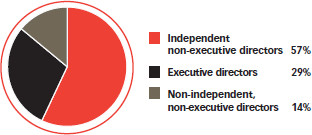 Composition of board – 30 June 2010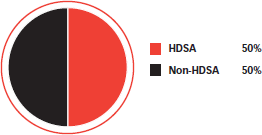 | ||
| Ensuring integrity and ethics in all aspects of the business. | Harmony’s Code of Ethics commits the company, its employees and contractors to a set of values that embodies the highest ethical standards and prohibits conflicts of interest. These values include transparency, trust, accountability, respect, equality and responsibility. An Ethics Committee meets quarterly to monitor ethical behaviour within Harmony’s business environment. Harmony employees are encouraged to use the company’s whistle-blowing or crime line, which is managed by an external security contractor and is accessible 24 hours a day. | The Code of Ethics will be brought in line with the provisions of King III. |
| Ensuring appropriate levels of risk management and mitigation. | Harmony has a formal risk policy framework and an extensive risk management structure to manage all categories of risk. The risk factors and primary risks identified in FY10 and how they are being managed are comprehensively covered under the Risk management section of this annual report and in the Form 20-F. Safety, health, environment and human rights risks are evaluated, and appropriate levels of due diligence are applied prior to engaging in significant contracts. A precautionary approach is taken in the planning and developing of new projects in compliance with South African legislation and good practice. | Ongoing adoption of best practice and alignment with King III. |
| The ability of the company to produce profitable, safe ounces of gold. | Harmony delivered a satisfactory financial performance for the year. Total gold production of 1.43 million ounces (44 433 kilograms) declined by 2% compared with the previous year, largely as a result of the planned closures of shafts and mines in South Africa. Regrettably, there were 22 fatalities across the group during the year – see safety discussion below. | Harmony aims to produce 1.7 million ounces of gold in FY11, growing to 2 million ounces in FY13. Harmony’s aim is to achieve these targets safely – eliminating all fatal accidents. |
| The gold market and exchange rates which influence the company’s profitability. | Although international financial markets have not yet fully stabilised following the recent global economic crisis, Harmony believes that gold remains a profitable product and expects the gold price in dollar terms to be sustained and possibly even to increase in the medium to long term. Harmony is highly exposed to the R/$ exchange rate, given that the bulk of the company’s current operations are based in South Africa. While Harmony’s earnings are determined by dollar gold prices, its costs are largely incurred in rands. The rand:dollar exchange rate has over the past year proved to be remarkably resilient. The strengthening of the rand against the US dollar throughout FY10 placed continued pressure on Harmony’s profit margins. | Harmony remains positive on gold. However, the gold price and exchange rate are not within the company’s control. Harmony’s strategic plans for FY11 have been based on a gold price of R250 000/kg, assuming a gold price of $950/oz and an exchange rate of R8.19/US$, with financial modelling done at R275 000/kg. |
| The company’s investment in the future – exploration and development to sustain operations and to grow. | A key feature of FY10 was the restructuring of Harmony’s asset portfolio in line with its production targets. This is discussed further in the Chief executive officer’s review. In addition, the company spent R3.3 billion on capital expenditure in FY10, largely on the group’s four growth projects in South Africa and the development of Hidden Valley in PNG. Harmony has spent R15.4 billion on capital projects over the past five years. For more detail on Harmony’s growth projects, see Chief executive officer’s review, Review of operations: South Africa and Hidden Valley | Ongoing development of growth projects. R3.4 billion allocated for capital expenditure and R377 million for exploration in FY11. |
| Economic transformation and empowerment. | Harmony is committed to economic transformation and empowerment in South Africa and PNG: | |
| South Africa: Harmony has achieved compliance with the Mining Charter through partnerships and the sale to HDSA companies of interests in the company and its underlying operations. At 30 June 2010, around 36%of production was attributable to HDSA interests. See discussion on affirmative procurement below. | Maintain HDSA interests at current levels. | |
PNG: | Continue to maintain and develop relationships, and comply to all requirements of the MOA. | |
Social performance
The social dimension of sustainability concerns the impact the organisation has on the social environment in which it operates. Comprehensive discussions on the safety, occupational health and well-being, labour practices and community issues may be found in the Sustainable Development Report.
| Issue | Performance in FY10 | Targets for FY11 |
|---|---|---|
| There are two primary material issues regarding employee and community safety for Harmony, namely: | ||
| The elimination of accidents, by managing risk and ensuring the appropriate structures, systems and training are in place. | Regrettably, 22 employees lost their lives in mine-related incidents in FY10 (FY09: 22). A total of 21 of these fatalities were at the South African operations. | Elimination of fatalities. |
| South Africa: The FIFR remained unchanged year-on-year at 0.21,while the LTIFR improved by 17.3% to 7.73 per million hours worked (FY09: 9.35). The RIFR improved by 16% to 4.19 per million hours worked compared to FY09 (4.97). The all injury frequency rate (AIFR) improved by 9% to 17.05 per million hours worked (FY09: 18.73). A total of 27 254 shifts were lost as a result of occupational injury or illness, a 19% improvement on the previous year (FY09: 33 812). Comprehensive safety programmes are in place to reduce the incidence of accidents, particularly fatalities. While lost time and all injuries have consistently declined, the FIFR remained unchanged year-on-year. | Ongoing improvement in lagging and leading indicators. | |
South Africa: Fatalities FY08 – FY12 (R million)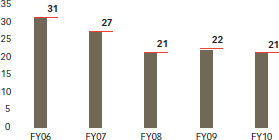 South Africa: FIFR (per million hours worked) South Africa: LTIFR (per million hours worked) South Africa: AFIR (per million hours worked)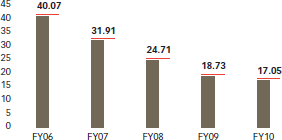 |
||
| PNG:The FIFR increased to 0.1 per million hours worked (FY09: 0), as did the LTIFR year-on-year to 0.7 per million hours worked (FY09: 0.1). The AIFR increased by 15% to 37.4 per million hours worked (FY09: 32.5). | Elimination of accidents. | |
PNG: LTIFR (per million hours worked)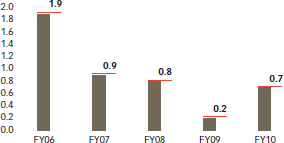 PNG: AIFR (per million hours worked)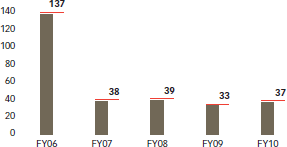 | ||
| Addressing the issue of illegal miners in South Africa. | Harmony does everything reasonably practicable to ensure the safety of its workers. Illegal or criminal mining activities, however, endanger the criminals’ own safety as well as that of company employees. Criminal mining is an organised crime and Harmony can only deal with level one of this crime, being the criminal miner. Harmony proactively addressed illegal mining activities in FY10 by liaising with the DMR, the South African Police Service (SAPS), the Department of Justice, private security companies, local businesses and affected communities. Further tripartite negotiations and investigations initiated by the minister of Mineral Resources are currently under way. The company also communicates regularly with employees across the board on the effects of illegal mining. In FY10, Harmony’s close working relationship with the unions assisted in the implementation of a ‘food ban’ at the Free State operations with the aim of controlling illegal mining. Among various other initiatives, access control measures have been upgraded at Harmony’s operations with regular security surveys underground implemented to curb illegal mining activities. | Eliminate illegal mining, as far as this is practically possible. |
| Issue | Performance in FY10 | Targets for FY11 |
|---|---|---|
| Appropriate levels of surveillance and care for safe, healthy and productive employees. | South Africa: In compliance with the Mine Health and Safety Act, medical surveillance (57 045 medical surveillance examinations) continued at the group’s four medical surveillance centres. In total 442 cases of NIHL were identified in FY10 (FY09: 478), while a total of 452 cases were compensated. There were 881 suspected cases of silicosis identified and 400 cases were compensated. There has been a gradual downward trend in silicosis over the years. A large percentage of the silicosis cases submitted are non-compensable as the introduction of the sensitive digital X-ray technology in FY05 has resulted in early and over-reporting. | Harmony has committed to industry milestones for NIHL and silicosis under the auspices of the Mine Health and Safety Council (MHSC). See the Sustainable Development Report. |
South Africa: New cases of NIHL identified
| ||
| PNG: The medical centres at Wafi and Wau provide full-time primary healthcare and occupational health surveillance to PNG employees, their dependants and the local community (in emergency situations only). The Hidden Valley medical centre provides full-time primary healthcare and occupational health surveillance to employees only. | Continue ongoing surveillance for potential occupational illnesses. | |
| Effective disease management among employees and community members. | South Africa: Despite high HIV infection levels, the TB rate is in gradual decline. A total of 1 302 cases were diagnosed (1 485 in FY09). Access to Highly Active Anti Retroviral Therapy (HAART) for the treatment of HIV & AIDS is available to all company employees through the company’s comprehensive HIV & AIDS programme, at the company’s health care facilities, or through private medical aid schemes when appropriate. In FY10, a total of 3 226 employees participated in the company’s HAART programme, compared with 4 255 in FY09. It is possible that fluctuations in population numbers have contributed to this decline. | Maintain highly effective TB and HIV programmes with the aim of continuing to see a decline in TB, with more people under active HIV & AIDS management. |
South Africa: Number of employees on HAART
|
||
| PNG: Health contacts decreased in FY10 as a result of a reduction in staff and contractors on site as the Hidden Valley mine began production. Primary health issues are upper respiratory tract infections and malaria, neither of which are occupational illnesses. MMJV administered a cholera vaccination programme to high-risk staff at all its operations as well as an education programme for employees and the surrounding communities. No cases of cholera were identified at the MMJV medical centres. | Maintain health management programmes and be responsive to public health threats. | |
| Issue | Performance in FY10 | Targets for FY11 |
|---|---|---|
| Recruiting, developing, managing and retaining employees through initiatives such as ABET, training and development and the leadership and supervisory development programmes. | Total staff turnover – 15% in South Africa and 13% in PNG. This is a significant decrease in the turnover rate and can be attributed to the company’s range of retention initiatives. In line with Harmony’s goal of investing in the training and development of current and potential employees, skills development programmes are offered by the company. A total of 30 747 employees were trained during the year in South Africa, at a cost to company of some R23.01 million. With the specific focus on the training and development of HDSAs to facilitate transformation, 90% of the employees trained in FY10 were HDSAs with 11% of them being women. To address the skills needs in PNG, mentoring and skills development programmes were commenced in FY10. These programmes will assist in the company’s objective of retaining its employees. | Ongoing training and development of employees. |
| Developing and ensuring diversity above required compliance levels. | South Africa: In South Africa, recruitment, development and retention initiatives are focused on HDSAs in line with the Mining Charter’s requirement that HDSA employees make up 40% of management in South Africa by 2009. Harmony’s representation of HDSAs in management was 40% for FY10 (FY09: 37%). In line with the Mining Charter stipulation that 10% of the total workforce should be women, the representation of women across the Harmony group in FY10 was 12% (FY09: 11%). | Maintain or exceed target of 40% HDSAs in management and 10% women in mining. |
South Africa – HDSAs in management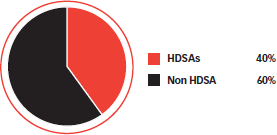 South Africa – Women in mining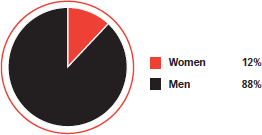 | ||
| PNG: The localisation process continued at PNG with an emphasis on locally recruited employees (LREs) being hired. Around 8% of the workforce was madeup of foreign labour in FY10. Percentage of women employed was 15% at year-end. | 96% LREs employed by FY12. New leadership development programme to support this. Target of 17% women in mining by FY13. | |
| Promoting sound and constructive industrial relations. | South Africa: Harmony is committed to freedom of association for employees and collective bargaining. Around 88% of the South African workforce is unionised or covered by collective bargaining agreements. Industrial relations in South Africa were positive and constructive in FY10. | Maintain constructive relations with employees and unions and avoid industrial action. |
| PNG: There are no active unions at MMJV and Harmony PNG sites. Industrial relations at the Hidden Valley site are currently overseen by the Employee Representative Committee (ERC) in conjuction with MMJV management. | Engage in constructive employee relations in PNG. | |
| Issue | Performance in FY10 | Targets for FY11 |
|---|---|---|
| There are four primary material issues for Harmony in respect of working with our communities for Harmony, namely: | ||
| Identifying and implementing sustainable socio-economic development initiatives such as enterprise and community skills development in line with Harmony’s business philosophy, and in compliance with our commitments. | South Africa: Harmony undertakes corporate social responsibility (CSR)/local economic development (LED) in four key areas – education; socio-economic development; sports, arts and culture; and broad-based black economic empowerment (BBBEE) support – in its mining and labour-sending communities. CSR further encompasses broader community development and includes national socio-economic development programmes such as mathematics and science development. LED initiatives are undertaken in line with the requirements of the Mining Charter, MPRDA regulations and the Codes of Good Practice for the Minerals and Mining Industry. During FY10 Harmony spent a total of R58.82 million (FY09: R10.7 million) on LED projects and some R23.08 million (FY09: R16.9 million) on CSR projects. | Continue to implement CSR and LED programmes in line with the company’s policy and in compliance with the Mining Charter. |
| PNG : In PNG Harmony’s socio-economic development programmes for the benefit of the communities in which Harmony operates, were aimed at addressing health, education, agriculture and infrastructure priorities. | Continue to implement socio-economic development programmes in line with agreements. | |
| Affirmative procurement with an emphasis on promoting business with HDSAs, women and local communities. | South Africa: Harmony is committed to the transformation of its procurement practices and performance. Harmony’s broad-based black economic empowernment (BBBEE) procurement expenditure in FY10 amounted to R2 036 million (38% of total expenditure). Harmony’s BBBEE spend by category for FY10 was as follows: capital at R1 498 million (27%); services at R307 million(5%); and consumables at R231 million (4%). Harmony’s enterprise development centres, now operational in Welkom and Soweto, were structured to support affirmative procurement with the aim of making it easier for BBBEE suppliers to conduct business with Harmony. | Continue affirmative procurement strategies compliance with the Mining Charter and DTI targets. Target of 42% has been set for FY11, and a progression plan of 2% per annum to end at 48% by FY14. |
BBBEE procurement versus SLP targets (%)
| ||
| Improving employees’ housing and living conditions. | In South Africa, Harmony’s housing strategy encompasses the promotion of home ownership as well as the integration of mining communities into local structures. In FY10 this strategy focused on the upgrading of hostels and the hostel de-densification project in compliance with Charter requirements. Approximately 80% of Harmony’s hostels have been converted to accommodate two people per room. At PNG operations, employees are from the surrounding area and therefore live in their own accommodation when on field breaks. | Continued compliance with SLP commitments. |
| Developing and promoting sound and responsive internal and external relationships through effective stakeholder engagement. | South Africa: Harmony undertakes active and ongoing engagement with stakeholders. Harmony’s LED priorities are stakeholder-driven and guided by a stakeholder engagement process involving the appropriate municipalities, communities, the DMR, NGOs and governments of the labour-sending countries of Lesotho, Mozambique and Swaziland. | Continue to undertake stakeholder engagement and to deal constructively and rapidly with any issues raised. |
| PNG: Harmony has undertaken extensive community engagement programmes to address the community’s concerns over the environmental impacts of the mine, particularly those concerning the Watut River sedimentation issues. | Continue to undertake stakeholder engagement and to deal constructively and rapidly with any issues raised. | |
Environment
The environmental dimension of sustainability concerns an organisation’s impact on living and non-living natural systems, including ecosystems, land, air, and water. Environmental indicators include performance related inputs (e.g. material, energy, water) and outputs (e.g. emissions, effluents, waste). In addition, they cover performance related to biodiversity and environmental compliance and other relevant information such as environmental expenditure and the impacts of products and services. A comprehensive discussion of the company’s environmental performance may be found in the Sustainable Development Report.
| Issue | Performance in FY10 | Targets for FY11 |
|---|---|---|
| There are four primary material issues in respect of environmental performance for Harmony, namely: | ||
| Implementing environmental management and auditing systems that ensure compliance with legislation and regulation in the countries in which Harmony operates as well as compliance with the company’s own internal policies and standards. | South Africa: Harmony is implementing environmental management systems that ensure compliance with legislation and regulation by all operations, and that environmental management is addressed formally and systematically. In line with the MPRDA, environmental management plans (EMPs) were drawn up for each operation and submitted and agreed to by the DMR. Amendments to these plans are made as and when required. Harmony is continuing with the implementation of ISO 14001 at all its operations – Doornkop has been certified as being compliant. | All operations will operate and comply with ISO 14001 standards, while all new and long-life assets will be ISO certified within the next three years. |
| PNG: MMJV is currently developing an integrated sustainable business management system (SBMS) which, when implemented, will meet the requirements of ISO 14001 and other relevant international safety and community standards. | The development and implementation of the environmental principles and standards of the SBMS. Full implementation of the SBMS is targeted for FY12. | |
| The responsible use of resources such as energy and water. | South Africa: As Harmony’s operations make extensive use of water, the company has embarked on a group-wide campaign to reduce the consumption of fresh water whilst optimising the re-use of process water. The total water used for primary activities in FY10 increased to 44 338 781m³. Potable water used declined by 7.7%. Of the total volume of water used during the year, approximately 31% was recycled. Most of the energy consumed by Harmony is in the form of electricity drawn from Eskom, the national energy utility. Eskom is primarily driven by coal-fired power stations. Hoisting, cooling and ventilation systems all require significant amounts of electrical power and make the company a considerable user of electricity. Energy is therefore a major part of Harmony’s operating costs with this being increased in the last two years by rising electricity tariffs. In FY10, total electrical energy consumption was 3 659 376MWh (FY09: 3 444 444MWh) for the South African operations, a negligible increase from FY09. | Group targets have been set for energy and fresh water usage. These targets include operations with total emissions exceeding 100 000 tonnes CO2e to have and maintain energy conservation plans by 2012. The group target is to reduce energy consumption by 10% per tonne milled (base year 2005). In addition the company aims to reduce fresh water consumption by 2% by 2013 and to improve the use of affected water by 5% by 2013. |
Water consumption
| ||
| PNG: Water is the most significant resource used by MMJV. In FY10 modifications were made to the Hidden Valley processing plant to significantly reduce the amount of fresh water used and to increase the amount of treated recycled water utilised in the process. Total water usage at PNG in FY10 was 1 843 000m³. | Further opportunities to reduce fresh water use will be explored. The most significant initiative to reduce the amount of energy used at Hidden Valley is the connection to the new national hydro-power transmission line planned for FY11. This will reduce the reliance on diesel-generated power on site. The main goal for MMJV operations is to switch the Hidden Valley mine’s generation of electricity from diesel to hydroelectric sources through the PNG electricity grid. This major change in fuel consumption is on target for completion in FY11. | |
| Ensuring appropriate risk management practices and mitigation measures are in place to prevent or minimise the company’s impact on the environment. Specific areas of concern include the management of cyanide, water pollution abatement, addressing acid mine drainage (AMD), and understanding and developing plans to deal with climate change. | Appropriate risk management practices and mitigation measures are in place to prevent or minimise the company’s impact on the environment. Specific areas of concern include the management of cyanide, the discharge of water to the environment, addressing AMD, and understanding and developing plans to deal with climate change. South Africa: There were five significant environmental incidents reported in South Africa in FY10. Harmony has been a signatory to the International Cyanide Management Code for the Manufacture, Transport and Use of Cyanide in the production of Gold (the Cyanide Code) since June 2007. The Cyanide Code, developed by the United Nations’ Environment Programme and the International Council on Mining and Metals (ICMM), is a voluntary industry programme for companies involved in the production of gold using cyanide. Four plants in South Africa have been certified with substantial compliance. In FY10, Harmony used 7 884 tonnes of cyanide (FY09: 6 304 tonnes) in South Africa. Harmony participated in the global Carbon Disclosure Project (CDP) in FY10. Harmony’s total scope 1 and 2 emissions in FY10 in South Africa were 4 402 675 tonnes CO2e (FY09: 4 183 373 tonnes CO2e). These emissions are mostly indirect and a consequence of electricity used and purchased from Eskom. | Targets include ongoing risk management to prevent and mitigate environmental incidents, continued implementation of and compliance with the Cyanide Code, and reducing GHG emissions by 5% by 2013. |
| PNG: Apart from the impacts on the Watut River, which are discussed in detail in the Sustainable Development Report, there were a number of environmental incidents reported in PNG that have had a minor impact on the environment. These were not considered major or at a level that would have any effect on the ecosystem. Hidden Valley mine is implementing the Cyanide Code, and is preparing for certification in the latter part of FY11. The processing plant was designed to comply with the Cyanide Code and a gap analysis has been commissioned to identify any key actions necessary to meet Code’s requirements. Harmony is developing a framework for establishing an internal GHG management strategy, including standardised emission measurements and estimation techniques at PNG. GHG emissions in PNG are only direct and treated as scope 1 emissions as they are all generated from diesel generators and no electricity is purchased. In FY10, total emissions increased by 65% to 128 371 CO2e. This is because the Hidden Valley mine, previously in development, is now fully operational. | Targets for PNG include:
| |
| Ensuring that closure plans are in place, including appropriate funding mechanisms, and that rehabilitation and closure are planned for during the life of mine, and undertaken at closure. | Closure plans are developed as required, and appropriate funding mechanisms are in place at all operations. As far as possible, rehabilitation and closure are planned for during the life of mine, and undertaken at closure. This is a key priority for Harmony. South Africa: The total rehabilitation liability was estimated at R2 229 million at June 2010, while funding was R1 987 million. PNG: A closure plan has been developed for Hidden Valley and the provision for rehabilitation and closure liabilities is US$52.7 million. | Develop closure plans for all operations. Conduct annual review of closure liabilities and continue provision for rehabilitation and closure funding. |
HARMONY ANNUAL REPORT 2010
